The terminator may not come at any time soon but medicines should be coming soon at a printer near you …
Mid last year, Gartner mentioned “medical applications [of 3D printing] will have the biggest impact in the next two to five years“. With 3D printing you can already create a lot of physical artifacts and medical applications go from building medical equipments to prosthetic parts, but also blood vessels, bone, heart valve, cartilage, etc. Complete organs are not too far, with companies like Organovo already printing functional liver assays, prospects to restore a body by replacing or consolidating personalized parts seem interesting.
On the other side, restoring a body function by providing personalized molecules was a dream so far. Preventing body malfunction via similar systems is too.
 I recently watched and read about Lee Cronin’s laboratory work and these dreams may come true, one of these days. In a TEDxGateway video in 2013, Prof. Cronin explained briefly how he did it. Last December, they published their method with a basic application in Nature Communications. What I also liked is that, beyond the technical capabilities, this research is based on common components (right) and free software that are available for everyone. And Cronin also insisted on compatibility between “recipes” and the possibilities to exchange them as well as source code – one day, will their software be released on Github like some of their 3D models as STL files?
I recently watched and read about Lee Cronin’s laboratory work and these dreams may come true, one of these days. In a TEDxGateway video in 2013, Prof. Cronin explained briefly how he did it. Last December, they published their method with a basic application in Nature Communications. What I also liked is that, beyond the technical capabilities, this research is based on common components (right) and free software that are available for everyone. And Cronin also insisted on compatibility between “recipes” and the possibilities to exchange them as well as source code – one day, will their software be released on Github like some of their 3D models as STL files?
Cronin also talks about pharmaceutical companies releasing blueprints for drugs that could save plenty of lives in emerging economies, for instance. In my opinion, this is however where the technology goes much faster than the ideological framework we live in: pharma companies will not likely suddenly release recipes for drugs that bring them money (no for-profit company in any other sector would, by the way) and the regulatory framework for healthcare is far from ready to accommodate these advances.
Prevention could also benefit from these advances. Synthetic vaccines are in production since two decades at least. If safety is the first argument often put forward in their favor, rapid prototyping and versatile production could one day become possible. It seems it was already tested for flu vaccines. Now imagine to move the “engineering” part in a computer, sending the recipe for the best-adapted vaccine directly to “vaccine printers” in regions where health hazards are likely to occur or as early as they occur … We would also face many corporate and regulatory hurdles. But it wouldn’t be the first field where technology would push broader changes …














